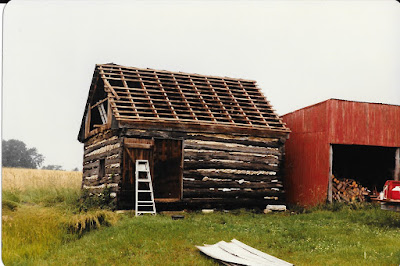How fortunate we are. . .
That we can now look back on old log buildings as symbols of the pioneer spirit and craftsmanship.
We look on them with a nostolgic feeling.
Many of us can now afford to rebuild and restore many old log buildings as fun hobbies and weekend homes. Others can afford the price of turning them into modern homes.
And while all this is well and good, and are things we should observe about old buildings in general, for many people they were a symbol of something else.
This month my daughters fifth grade class will start studying Plantation life and slavery.
The first log cabin I acquired for my own use I was told was an old slaves cabin.
Over the years it had been used for many things since it's time as a home for slaves, even as a grain bin.
I don't know for a fact that it had actually been used as a slaves home, but that is what I was told.
It had many of the signs of a slaves home, small windows and doors. Roughly built. Small. It could have been.
We honor white men who came from a log cabin background and made more of themselves, Abe Lincoln, U. S. Grant, Andrew Jackson.
And many of our frontier hero's started out in cabins or lived in them; Davie Crockett, Daniel Boone.
But for others, they could have been a symbol of oppression, never having the chance to move onto something better. The Slave.
While not all slave homes were built log cabin style, I would imagine a great many were, along with rough clap board siding or brick.
Slaves on larger plantations probably had slightly better built homes (especially if it reflected on the wealth of the owner) than the slave who lived on smaller less profitable farms.
I have posted on this blog several times images of slaves cabins.
These next two images are of a restored slaves cabin not to far from our place.
Today I thought I would add just a couple images of other slave cabins in Missouri. I have not seen any of these, and most probably no longer stand.
Most of us who love these old buildings and want to save them can look beyond how they look when we start taking them down. We can in our minds imagine how they will look when we are finished, using our modern tools with the latest materials.
But for the people who lived in them, they would probably never be much more the the rough structure we see in the photos.
They would never have the fine antiques we may put in them.
They may never have the efficient stove or fireplace we light on chilly nights.
Their floors may always have to be dirt.
And it would probably not be past on to their children.
Eight to ten people may have to live in one small cabin.
Probably no beds, at least for the children.
They probably spent as little time as possible inside.
Again, while slaves may not have been the only ones to start out in this hard scrabble life, they did not have the chance to make their situation better.
When I took this one down I did not own a piece of land to put it on.
I had to take the cabin if I wanted the old blue cook stove that I had gone to this farm to buy.
By the time I got land and had the money to rebuild a cabin the logs were no longer any good.
I wish I could change that.










No comments:
Post a Comment